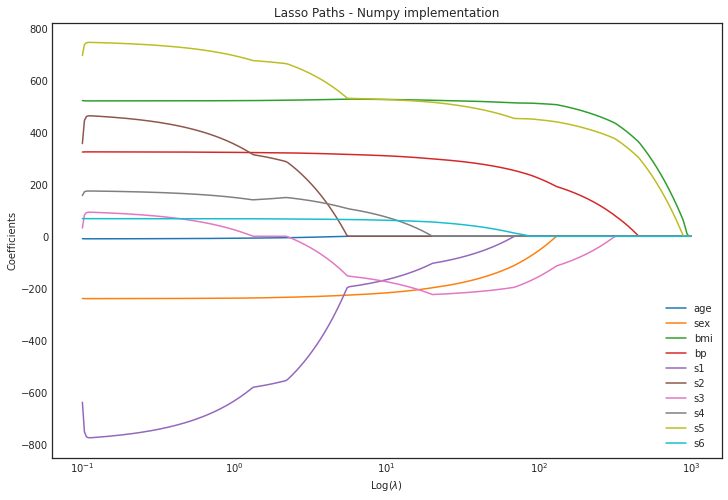Coordinate Descent from Scratch
Posted on * • 3 minutes • 472 words
Some notations:
$n$ - number of observations, $d$ - number of features
Lasso cost function
$$ \large{L(w) = \frac{1}{2} \Sigma_{i=1}^{n}(y_{i} - \Sigma_{j=0}^{d}{w_{j}x_{ij}})^2 + \lambda\Sigma_{j=0}^{d}\lvert w_{j} \rvert} $$
Taking the derivative with respect to the $w_{l}$
$$ \large{\frac{\partial L}{\partial w_{l}} = \Sigma_{i=1}^{n}(y_{i} - \Sigma_{j=0}^{d}{w_{j}x_{ij}}) \cdot x_{il} + \lambda \frac{\partial \lvert w_{l} \rvert}{\partial w_{l}}} $$
Can be rewritten as: $$ \large{\frac{\partial L}{\partial w_{l}} = \Sigma_{i=1}^{n}(y_{i} - \Sigma_{j \neq l}^{d}{w_{j}x_{ij}} - w_{l}x_{il}) \cdot x_{il} + \lambda \frac{\partial \lvert w_{l} \rvert}{\partial w_{l}}} $$
$$ \large{\frac{\partial L}{\partial w_{l}} = \Sigma_{i=1}^{n}(y_{i} - \Sigma_{j \neq l}^{d}{w_{j}x_{ij}}) \cdot x_{il} + w_{l}\Sigma_{i=1}^{n}x_{il}^2 + \lambda \frac{\partial \lvert w_{l} \rvert}{\partial w_{l}}} $$
let $$ \large{a_{l} = \Sigma_{i=1}^{n}x_{il}^2} $$ which, in case of normalized features, $$ \large{a_{l} = \Sigma_{i=1}^{n}x_{il}^2 = 1} $$
and let, $$ \large{\rho_{l} = \Sigma_{i=1}^{n}(\Sigma_{j \neq l}^{d}{w_{j}x_{ij}} -y_{i}) \cdot x_{il}} $$
with $\rho_{l}$ basically a function of the prediction without the feature $l$.
Ignoring the constant 2, we can rewrite $$ \large{\frac{\partial L}{\partial w_{l}} = \rho_{l} + w_{l}a_{l} + \lambda \frac{\partial \lvert w_{l} \rvert}{\partial w_{l}}} $$
The final partial derivative equation:

Soft threshold function
The closed form solution, for the normalized features

import numpy as np
import pandas as pd
from matplotlib import pyplot as plt
from mpl_toolkits.mplot3d import Axes3D
from mpl_toolkits import mplot3d
from sklearn import linear_model
from sklearn import datasets
%matplotlib inline
plt.style.use('seaborn-white')
Load Data
diabetes = datasets.load_diabetes()
X = diabetes.data
y = diabetes.target.reshape(-1,1)
diabetes = datasets.load_diabetes()
X = diabetes.data
y = diabetes.target.reshape(-1,1)
Define Soft threshold
def soft_threshold(rho,lamda):
'''Soft threshold function used for normalized data and lasso regression'''
if rho < - lamda:
return (rho + lamda)
elif rho > lamda:
return (rho - lamda)
else:
return 0
Define Coordnate descent
def coordinate_descent(theta,X,y,lamda = .01, num_iters=100, intercept = False):
'''Coordinate gradient descent for lasso regression - for normalized data.
The intercept parameter allows to specify whether or not we regularize theta_0'''
#Initialisation of useful values
m,n = X.shape
X = X / (np.linalg.norm(X,axis = 0)) #normalizing X in case it was not done before
#Looping until max number of iterations
for i in range(num_iters):
#Looping through each coordinate
for j in range(n):
#Vectorized implementation
X_j = X[:,j].reshape(-1,1)
y_pred = X @ theta
rho = X_j.T @ (y - y_pred + theta[j]*X_j)
#Checking intercept parameter
if intercept == True:
if j == 0:
theta[j] = rho
else:
theta[j] = soft_threshold(rho, lamda)
if intercept == False:
theta[j] = soft_threshold(rho, lamda)
return theta.flatten()
Run Lasso
# Initialize variables
m,n = X.shape
initial_theta = np.ones((n,1))
theta_list = list()
lamda = np.logspace(0,4,300)/10 #Range of lambda values
#Run lasso regression for each lambda
for l in lamda:
theta = coordinate_descent(initial_theta,X,y,lamda = l, num_iters=100)
theta_list.append(theta)
#Stack into numpy array
theta_lasso = np.stack(theta_list).T
Plot paths
n,_ = theta_lasso.shape
plt.figure(figsize = (12,8))
for i in range(n):
plt.plot(lamda, theta_lasso[i], label = diabetes.feature_names[i])
plt.xscale('log')
plt.xlabel('Log($\\lambda$)')
plt.ylabel('Coefficients')
plt.title('Lasso Paths - Numpy implementation')
plt.legend()
plt.axis('tight')
(0.06309573444801933, 1584.893192461114, -849.8147108555953, 820.6104516733536)


